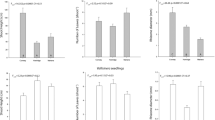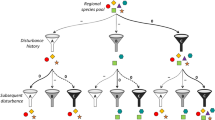Abstract
Submerged aquatic plants are ecosystem engineers that are able to modify their habitat. However, the role of patch size in the engineering capacity of aquatic plants has not yet been fully investigated, while it could be essential for elucidating the consequences of plant presence. Our objectives were to investigate the effects of patch size on plant-flow-sediment interactions in lotic ecosystems and to determine whether these effects differed according to environmental characteristics. We performed in situ measurements of velocity and grain size along natural patches of increasing length (L) at two sites presenting different flow and sediment characteristics. Our results indicated that a minimum patch size was needed to induce in-patch reduction of the time averaged velocity component in the flow direction (i.e. streamwise velocity) and fine sediment accumulation. Streamwise velocity decreased linearly with L independently of the site conditions. The sediment texture was instead dependent on site conditions: for the site characterized by higher velocity and coarser sediment, the sediment grain size exponentially decreased with L, reaching a minimum value at L ≥ 1.0 m, while for the site characterized by lower velocity and finer sediment, it reached a minimum value already at L > 0.3 m. This study demonstrated that a minimal patch size is required to trigger the ecosystem engineering capacity of aquatic plant patches in lotic environments and that this capacity increases with patch length. Small patches induce little to no modification of the physical habitat, with possible negative feedbacks for plants. With increasing patch size, the habitat modifications induced by plants become more important, potentially triggering positive feedbacks for plants.





Similar content being viewed by others
References
Badin A-L, Méderel G, Béchet B, Borschneck D, Delolme C (2009) Study of the aggregation of the surface layer of Technosols from stormwater infiltration basins using grain size analyses with laser diffractometry. Geoderma 153:163–171. https://doi.org/10.1016/j.geoderma.2009.07.022
Bornette G, Puijalon S (2010) Response of aquatic plants to abiotic factors: a review. Aquatic Sci 73:1–14. https://doi.org/10.1007/s00027-010-0162-7
Bouma TJ, van Duren LA, Temmerman S, Claverie T, Blanco-Garcia A, Ysebaert T, Herman PMJ (2007) Spatial flow and sedimentation patterns within patches of epibenthic structures: combining field, flume and modelling experiments. Cont Shelf Res 27:1020–1045. https://doi.org/10.1016/j.csr.2005.12.019
Bouma TJ, Friedrichs M, van Wesenbeeck BK, Temmerman S, Graf G, Herman PMJ (2009) Density-dependent linkage of scale-dependent feedbacks: a flume study on the intertidal macrophyte, Spartina anglica. Oikos 118:260–268. https://doi.org/10.1111/j.1600-0706.2008.16892.x
Bouma TJ, De Vries MB, Herman PM (2010) Comparing ecosystem engineering efficiency of two plant species with contrasting growth strategies. Ecology 91:2696–2704
Bruno JF, Kennedy CW (2000) Patch-size dependent habitat modification and facilitation on New England cobble beaches by, Spartina alterniflora. Oecologia 122:98–108
Caffrey JM, Kemp WM (1992) Influence of the submersed plant, Potamogeton perfoliatus on nitrogen cycling in estuarine sediments. Limnol Oceanogr 37:1483–1495
Carpenter SR, Lodge DM (1986) Effects of submersed macrophytes on ecosystem processes. Aquat Bot 26:341–370 doi. https://doi.org/10.1016/0304-3770(86)90031-8
Chen Z, Jiang C, Nepf H (2013) Flow adjustment at the leading edge of a submerged aquatic canopy. Water Resour Res 49:5537–5551. https://doi.org/10.1002/wrcr.20403
Cornacchia L, Van Der Wal D, Van de Koppel J, Puijalon S, Wharton G, Bouma TJ (2019) Flow-divergence feedbacks control propagule retention by in-stream vegetation: the importance of spatial patterns for facilitation. Aquat Sci 81:17
Cotton JA, Wharton G, Bass JAB, Heppell CM, Wotton RS (2006) The effects of seasonal changes to in-stream vegetation cover on patterns of flow and accumulation of sediment. Geomorphology 77:320–334. https://doi.org/10.1016/j.geomorph.2006.01.010
Donatelli C, Ganju NK, Fagherazzi S, Leonardi N (2018) Seagrass impact on sediment exchange between tidal flats and salt marsh, and the sediment budget of shallow bays. Geophys Res Lett 45:4933–4943
Folkard AM (2005) Hydrodynamics of model Posidonia oceanica patches in shallow water. Limnol Oceanogr 50:1592–1600
Fonseca M, Fisher JS (1986) A comparison of canopy friction and sediment movement between four species of seagrass with reference to their ecology and restoration Marine. Ecol Prog Ser 29:15–22
Fonseca M, Fisher J, Zieman J, Thayer G (1982) Influence of the seagrass, Zostera marina L., on current flow Estuarine. Coast Shelf Sci 15:351–364
Franklin P, Dunbar M, Whitehead P (2008) Flow controls on lowland river macrophytes: a review. Sci Total Environ 400:369–378. https://doi.org/10.1016/j.scitotenv.2008.06.018
Ganthy F, Sottolichio A, Verney R (2013) Seasonal modification of tidal flat sediment dynamics by seagrass meadows of Zostera noltii (Bassin d’Arcachon, France. J Mar Syst 109:S233–S240
Goring DG, Nikora VI (2002) Despiking acoustic Doppler velocimeter data. J Hydraul Eng 128:117–126. https://doi.org/10.1061/(ASCE)0733-9429(2002)128:1(117)
Hendriks IE, Sintes T, Bouma TJ, Duarte CM (2008) Experimental assessment and modeling evaluation of the effects of the seagrass Posidonia oceanica on flow and particle trapping Marine. Ecol Progress Ser 356:163–173. https://doi.org/10.3354/meps07316
Hendriks IE, Bouma TJ, Morris EP, Duarte CM (2009) Effects of seagrasses and algae of the Caulerpa family on hydrodynamics and particle-trapping rates. Mar Biol 157:473–481. https://doi.org/10.1007/s00227-009-1333-8
James WF, Barko JW, Butler MG (2004) Shear stress and sediment resuspension in relation to submersed macrophyte biomass. Hydrobiologia 515:181–191. https://doi.org/10.1023/B:Hydr.0000027329.67391.C6
Jones CG, Lawton JH, Shachak M (1994) Organisms as ecosystem engineers. Oikos 69:373–386. https://doi.org/10.2307/3545850
Liu C, Nepf H (2016) Sediment deposition within and around a finite patch of model vegetation over a range of channel velocity. Water Resour Res 52:600–612
McCave IN, Syvitski JPM (1991) Principles and methods of geological particle size analysis. In: Syvitski JPM (ed) Principles, methods and application of particle size analysis. Cambridge University Press, Cambridge, pp 3–21. https://doi.org/10.1017/CBO9780511626142.003
Mori N, Suzuki T, Kakuno S (2007) Noise of acoustic Doppler velocimeter data in bubbly flows. J Eng Mech 133:122–125. https://doi.org/10.1061/(ASCE)0733-9399(2007)133:1(122)
Nepf HM (2012) Flow and transport in regions with aquatic vegetation. Annu Rev Fluid Mech 44:123–142
Phillips JM, Walling DE (1999) The particle size characteristics of fine-grained channel deposits in the River Exe Basin, Devon, UK. Hydrol Process 13:1–19. https://doi.org/10.1002/(SICI)1099-1085(199901)13:1%3C1::AID-HYP674%3E3.0.CO;2-C
Pluntke T, Kozerski HP (2003) Particle trapping on leaves and on the bottom in simulated submerged plant stands. Hydrobiologia 506:575–581. https://doi.org/10.1023/B:Hydr.0000008569.29286.Ec
Puijalon S, Bouma TJ, van Groenendael J, Bornette G (2008) Clonal plasticity of aquatic plant species submitted to mechanical stress: escape versus resistance strategy. Ann Bot 102:989–996. https://doi.org/10.1093/aob/mcn190
Sand-Jensen K (1997) Macrophytes as biological engineers in the ecology of Danish streams. In: Sand-Jensen K, Pedersen O (eds) Freshwater Biology. Priorities and development in Danish research. G.E.C. Gad, Copenhagen, pp 74–101
Sand-Jensen K (1998) Influence of submerged macrophytes on sediment composition and near-bed flow in lowland streams. Freshw Biol 39:663–679
Sand-Jensen K, Madsen TV (1992) Patch dynamics of the stream macrophyte, Callitriche cophocarpa. Freshw Biol 27:277–282. https://doi.org/10.1111/j.1365-2427.1992.tb00539.x
Sand-Jensen K, Mebus JR (1996) Fine-scale patterns of water velocity within macrophyte patches in streams. Oikos 76:169–180
Sand-Jensen K, Pedersen O (1999) Velocity gradients and turbulence around macrophyte stands in streams. Freshw Biol 42:315–328. https://doi.org/10.1046/j.1365-2427.1999.444495.x
Sand-Jensen K, Pedersen ML (2008) Streamlining of plant patches in streams. Freshw Biol 53:714–726. https://doi.org/10.1111/j.1365-2427.2007.01928.x
Sand-Jensen K, Prahl C, Stokholm H (1982) Oxygen release from roots of submerged aquatic macrophytes. Oikos 38:349. https://doi.org/10.2307/3544675
Schoelynck J, de Groote T, Bal K, Vandenbruwaene W, Meire P, Temmerman S (2012) Self-organised patchiness and scale-dependent bio-geomorphic feedbacks in aquatic river vegetation. Ecography 35:760–768. https://doi.org/10.1111/j.1600-0587.2011.07177.x
Schoelynck J et al (2013) Submerged macrophytes avoiding a negative feedback in reaction to hydrodynamic stress. Limnol Ecol Manag Inland Waters 43:371–380. https://doi.org/10.1016/j.limno.2013.05.003
Schoelynck J et al (2014) Different morphology of Nuphar lutea in two contrasting aquatic environments and its effect on ecosystem engineering. Earth Surf Proc Land 39:2100–2108. https://doi.org/10.1002/esp.3607
Schulz M, Kozerski HP, Pluntke T, Rinke K (2003) The influence of macrophytes on sedimentation and nutrient retention in the lower River Spree (Germany. Water Res 37:569–578
Soana E, Bartoli M (2013) Seasonal variation of radial oxygen loss in Vallisneria spiralis L.: an adaptive response to sediment redox? Aquat Bot 104:228–232. https://doi.org/10.1016/j.aquabot.2012.07.007
Souliotis D, Prinos P (2011) Effect of a vegetation patch on turbulent channel flow. J Hydraul Res 49:157–167
Tison J-M, de Foucault B (2014) Flora Gallica—Flore de France. Biotope edn.
van Wesenbeeck BK, van de Koppel J, Herman PMJ, Bouma TJ (2008) Does scale-dependent feedback explain spatial complexity in salt-marsh ecosystems? Oikos 117:152–159. https://doi.org/10.1111/j.2007.0030-1299.16245.x
Vandenbruwaene W et al (2011) Flow interaction with dynamic vegetation patches: Implications for biogeomorphic evolution of a tidal landscape. J Geophys Res-Earth 116:1–13. https://doi.org/10.1029/2010jf001788
Wentworth CK (1922) A scale of grade and class terms for clastic sediments. J Geol 30:377–392
Winemiller KO, Flecker AS, Hoeinghaus DJ (2010) Patch dynamics and environmental heterogeneity in lotic ecosystems. J N Am Benthol Soc 29:84–99. https://doi.org/10.1899/08-048.1
Zong L, Nepf H (2010) Flow and deposition in and around a finite patch of vegetation. Geomorphology 116:363–372. https://doi.org/10.1016/j.geomorph.2009.11.020
Zong L, Nepf H (2011) Spatial distribution of deposition within a patch of vegetation. Water Resour Res 47:W03516. https://doi.org/10.1029/2010WR009516
Acknowledgements
We thank Geraldene Wharton for her valuable comments on an earlier draft of this manuscript, Vanessa Gardette, Myriam Hammada, Youssouf Sy and Félix Vallier for field and laboratory assistance and the Compagnie Nationale du Rhône (CNR) for access to field sites. This research was supported by the Research Executive Agency through the 7th Framework Programme of the European Union, Support for Training and Career Development of Researchers (Marie Curie—FP7-PEOPLE-2012-ITN), which funded the Initial Training Network (ITN) HYTECH ‘Hydrodynamic Transport in Ecologically Critical Heterogeneous Interfaces’, N.316546. This study was conducted under the aegis of the Rhône Basin Long-Term Environmental Research (ZABR, Zone Atelier Bassin du Rhône).
Author information
Authors and Affiliations
Corresponding author
Additional information
Publisher’s Note
Springer Nature remains neutral with regard to jurisdictional claims in published maps and institutional affiliations.
Electronic supplementary material
Below is the link to the electronic supplementary material.
27_2019_635_MOESM1_ESM.eps
Online Resource 1 Sediment grain size distribution upstream of the patches of C. platycarpa at sites a) HV and b) LV. Patch number corresponds to a patch of increasing length (see Table 1). Sediment classification follows the Wentworth size classes (Wentworth 1922). (EPS 10380 KB)
27_2019_635_MOESM2_ESM.eps
Online Resource 2 Time-averaged vertical profiles of streamwise velocity (\(\bar {u}\)) for patches of C. platycarpa of increasing size (see Table 1). Velocity profiles were sampled in six positions along the main axis of the patch: upstream (U, right arrowhead), inside the patch at 10% (open circle), 30% (triangle), 50% (open diamond), and 90% (open square) of its length, and downstream (D, inverse triangle). The dashed line indicates patch canopy height. (EPS 24605 KB)
27_2019_635_MOESM6_ESM.pdf
Online Resource 3 Cumulative curves of the grain size distributions of sediment in different positions along the main axis of patches of C. platycarpa: upstream (U), inside the patch at 10%, 30%, 50%, and 90% of its length, and downstream (D). (PDF 445 KB)
Rights and permissions
About this article
Cite this article
Licci, S., Nepf, H., Delolme, C. et al. The role of patch size in ecosystem engineering capacity: a case study of aquatic vegetation. Aquat Sci 81, 41 (2019). https://doi.org/10.1007/s00027-019-0635-2
Received:
Accepted:
Published:
DOI: https://doi.org/10.1007/s00027-019-0635-2




